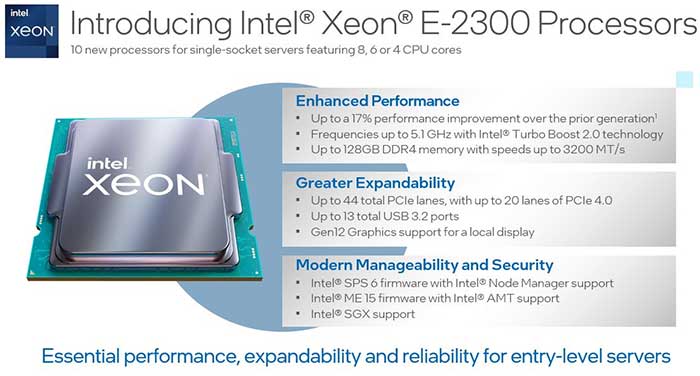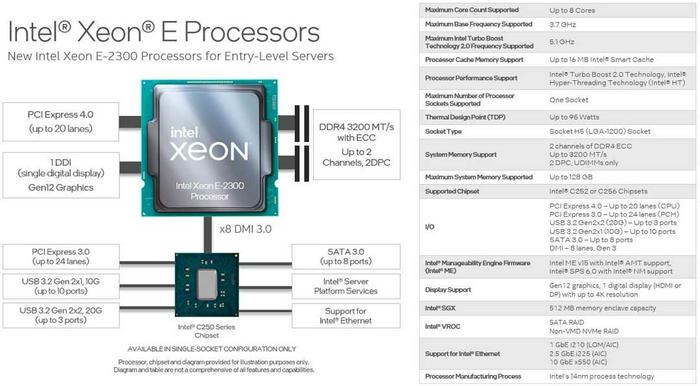Intel has released the Rocket Lake Xeon E-2300 server CPUs, aimed at single-socket entry-level server, and small business applications. This is the first update to the Xeon E-2X00 series since the Coffee Lake E-2200 family was introduced in Q2 2019, and requires the new Socket H5 (LGA 1200). The most important changes delivered with alongside this Rocket Lake silicon are improvements to the memory subsystem and support for PCIe 4.0 devices.

There are ten new Intel Xeon E-2300 processors now available. The range spans the: E2314 with 4C/4T, with base/boost clocks of 2.8/4.5GHz, 8GB of Smart Cache and 65W TDP (sans iGPU); up to the E2388G with 8C/16T, with base/boost clocks of 3.2/5.1GHz, 16GB of Smart Cache and 95W TDP (with Gen12 iGPU). It is good to see Intel eschew the 2C parts with this generation, but a top-end SKU with more cores seems to be ruled out by the harvestable RKL silicon.
Click to zoom table
Intel trumpets that the new Xeon E-2300 processors deliver up to 17 per cent faster performance to the prior generation thanks to the underlying RKL architecture tweaks, mostly the Cypress Cove core design. As, mentioned above, the new lineup delivers processors with up to 5.1GHz clock speeds. Memory performance is enhanced too, with the Rocket Lake Xeons supporting up to 128GB of dual-channel ECC DDR4 RAM, with speed up to 3200MT/s.
Click to zoom diagram
Moving onto enhanced expandability with the new platform, and Xeon E-2300 server CPUs provide up to 44 PCIe lanes, with up to 20 lanes of PCIe 4.0. Peripheral connectivity shouldn't be a bind either, with support for up to 13 USB 3.2 ports – three of which can be 20Gb (USB 3.2 gen 2x2) ports. The previous Xeon E-2200 platform was limited to 10Gb (USB 3.2 gen 2x1) at best.
Last but not least, for server folk, the new Rocket Lake Xeon E-2300 server CPUs feature a full range of modern manageability and security features such as Intel SGX (Software Guard eXtensions) support.
If you are interested in these new server processors, they should be available soon via your usual vendor, and you can check the MSRPs in the specs table above.
HEXUS reviewed the Intel Xeon Platinum 8380 Processor 2P (Ice Lake) in April this year, a higher end SKU family based on the Sunny Cove architecture, with up to 40 cores, large caches, up to 2 CPU sockets, 8 DIMM channels, and more.















